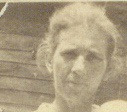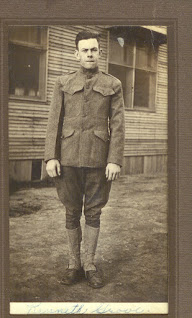Russell/Grove Families and the 1918 Flu Pandemic
My first recollection of the mention of Aunt Cynthia Grove Russell was in 1962 when my paternal grandfather, John Edwin Grove, casually referred to her during a car ride return trip from Parker, KS to Wichita.
Parker was the hometown of my Grove ancestors and in 1962 we spent Memorial Day there (called Decoration Day by my grandparents). That visit was memorable as it is the first time I visited Goodrich Cemetery, the site of the graves of several generations of my Grove ancestors. It was also the first time my father, John Virgil Grove, pointed out to me his boyhood home on Taft St. in Parker.
On that car ride home, I started asking questions about the graves we had seen and how I was related to those Groves. In retrospect it was probably this trip that inspired my genealogical hobby.
My grandfather mentioned that the Russell graves we had seen were victims of the Spanish Flu. I knew flu as an illness but not a killer. So, I was curious how it caused death. My grandfather was 12 in 1918. He remembered his Dad’s sister Aunt Cynthia quite well and her children, Donald, Anna, Merle. By 1918 Cynthia had been a widow for 25 years. She was living in Kansas City and had become the matriarch of the Grove family.
Tragedy struck in January, 1918. Cynthia had moved from Parker to Kansas City where she died January 9, 1918 at age 64. According to her death certificate she had been sick ten days with catarrhal pneumonia. Aside from that her health had been good. Her son Donald Delos Russell, who also lived in Kansas City, became ill returning from the cemetery in Parker after his mother’s services. He had a cold which led to pneumonia causing his death on January 15, 1918, at the home of his uncle Charles Grove (my great grandfather) at the age of 34. Cynthia’s daughter Anna Belle Russell South also accompanied her mother to Parker and she “suffered from a nervous breakdown,” was sick ten days and died at the home of her uncle, Charles Grove (my great grandfather) in Parker on January 23, 1918, at the age of 45.
In the span of two weeks 3 Russell family had members died. By 1962 the family lore had attributed these three deaths to what was then called the Spanish Flu. Since two of the three deaths occurred at my grandfather’s boyhood home, he was likely a witness and had a vivid memory of their passing.
One hundred years later there has been further research into the 1918 Flu Pandemic. More is known about its toll and its origin. As of this writing there is a strong belief that the 1918 outbreak did not originate in Spain. As a non-combatant in World War I the Spanish were more open about the outbreak among the population there than were the other European warring countries who did not want to disclose any events that might be perceived to their enemies as weaknesses. So, flu deaths among troops and the general population was not widely reported.
While the so-called “Spanish Flu” did not originate in Spain, scientists are still unsure of its source. France, China and Britain have all been suggested as the potential birthplace of the virus, as has the United States, where the first known case was reported at a military base in Kansas on March 11, 1918.
Now here’s where family lore meets historical facts. The first known case in the US was reported at a military base in Kansas on March 11, 1918. That military base was Camp Funston, a U.S. Army training camp located on Fort Riley, southwest of Manhattan, Kansas
The first Russell death was in Kansas City on January 9, 1918, 67 days before the first reported case at Camp Funston. Based on today’s information it is unlikely that these three closely related deaths of healthy family members can be attributed to the 1918 Pandemic OR is it possible that there were flu deaths within the general population in Kansas in early 1918 that were not reported due to the rural nature of the population?
In early January-February, 1918, Dr. Loring Miner, a Haskell County, Kansas, doctor raised the first warning, reporting an "influenza of a severe type" circulating in the area. Haskell County boys may have then carried the virus to a Kansas army camp. From there, the virus caught a ride with tens of thousands of young soldiers on their way to Europe.
The deaths in Kansas City in October 1918 that were recorded as part of the pandemic were worse than the rate of other major American cities. *Over the next 27 weeks, the flu would kill an estimated 2,300 people in Kansas City, giving it a mortality rate greater than New York, Chicago, Cleveland, Detroit and even St. Louis, a city with more than 2.5 times Kansas City’s population at the time.
In Parker not only did the two adult Russell siblings succumb to pneumonia but the weekly Parker Message reported in the Thursday, January 17, 1918 edition an unusual number of deaths for a community of approximately 400.
It is about 145 miles northwest from Parker, KS to Camp Funston and about 122 miles directly west of Kansas City.
Mrs. Cynthia Russell W.J. Boyd
Wife of W.J. Boyd Don Russell
Andrew J. Hill JJ Deihm
Six Deaths in Past Week
It has been a long while since there has been as many deaths in this community as there has been in this past week.
Friday, the body of Mrs. Cynthia Russell, a former resident of Parker was brought here from Kansas City for burial. The obituary will appear next week.
A son of Mrs. Russell, Don accompanied the body of his mother here for burial was taken sick with cold and it developed into pneumonia causing his death Tuesday morning about 5:00am he leaves a wife and several children besides other relatives.
One week later the death of Anna Belle Russell had died bringing the toll on this small community to seven.
More recently I started using Newspaper.com to scour online newspapers to discover more about my ancestors and discovered this in the March 21, 1918 Parker Message
Mrs. Chas. Grove (Kate Short Grove my great grandmother) returned Saturday from a two weeks’ visit with her son Kenneth who is in camp at Camp Funston and her daughter, Mrs. J Brown (my grandfather’s oldest sibling, Fern).
SO, it appears at the exact same time that Camp Funston was experiencing great numbers of soldiers suffering from the start of the epidemic, our ancestors were there! Is it possible Kenneth was ill and that’s why they visited? How did they not get infected while visiting Kenneth. Or, did they get sick while visiting and had to stay for two weeks to recover?
©John M Grove 2020





No comments:
Post a Comment